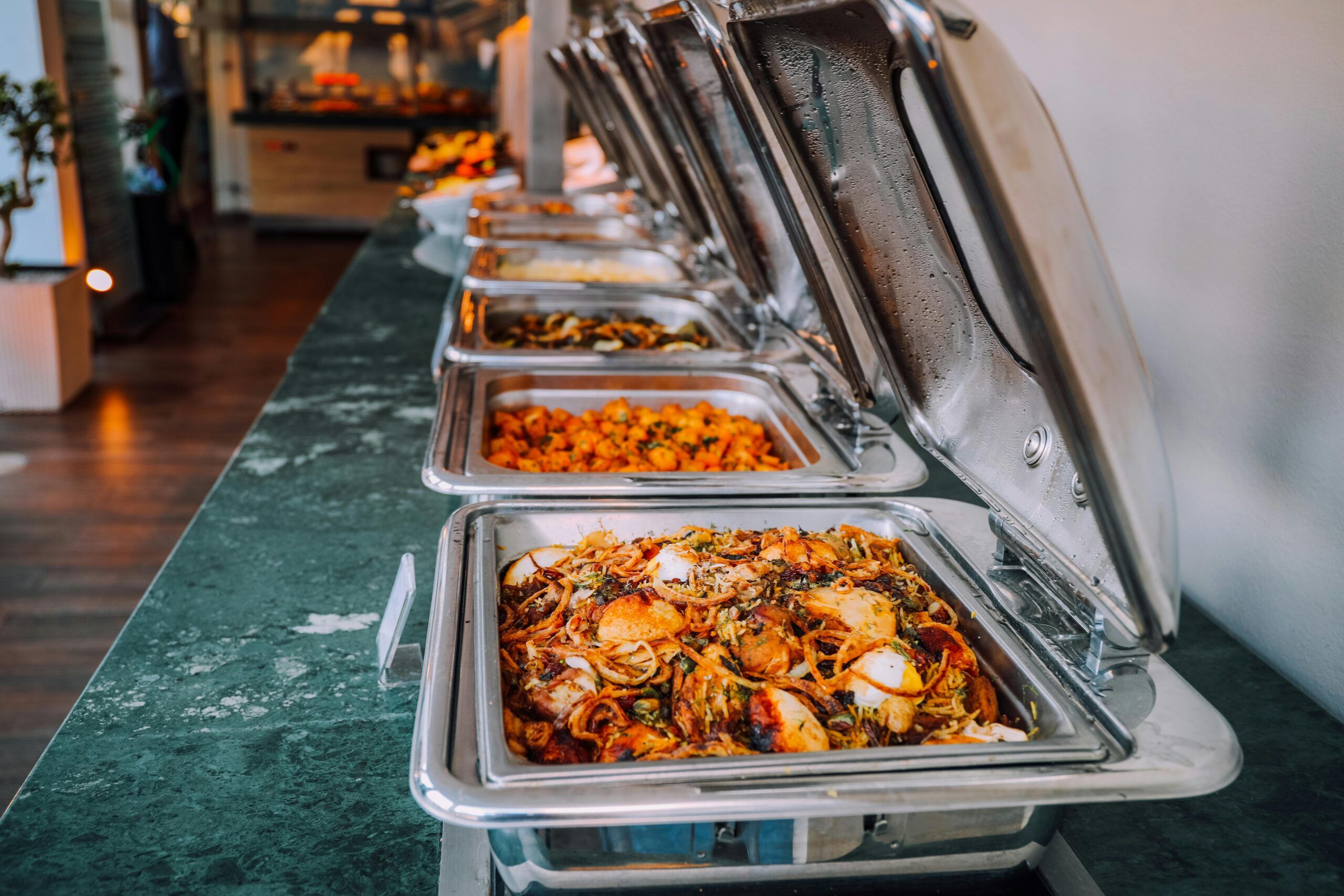- Why a Well-Designed Catering Menu Matters
- Step 1: Define Your Catering Concept and Audience
- Step 2: Choose Your Menu Items Strategically
- Step 3: Price Your Catering Menu Profitably
- Step 4: Organize and Format the Menu for Clarity
- Step 5: Offer Tiered Packages or Customization Options
- Catering Menu Examples for Inspiration
- How Orders.co Helps You Manage Catering Like a Pro
- Final Thoughts
- FAQ
If you’re looking to grow your catering business, your menu is a good place to start.
A well-crafted catering menu showcases what you offer, helps your team stay organized, and streamlines order management across various channels.
Knowing how to make a catering menu can save you time and reduce mistakes. A simple, easy-to-read format also helps clients feel more confident placing large or custom orders.
Whether you’re building a menu from scratch or updating one you already use, this guide will walk you through each step.
We’ll also include catering menu examples, pricing tips, and layout ideas to help you create something valuable for both you and your customers.
Looking for an easier way to manage your catering menu? Book a demo with Orders.co to simplify your catering operations.
Key Takeaways
- Define your catering concept and target audience first.
- Choose simple, prep-friendly menu items that travel well.
- Price carefully by calculating all costs, not just food.
- Organize the menu with clear sections and easy-to-read formatting.
- Offer packages and customization options to simplify orders.
- Keep your menu updated across all platforms using centralized tools.
If you’re looking to grow your catering business, your menu is a good place to start.
A well-crafted catering menu showcases what you offer, helps your team stay organized, and streamlines order management across various channels.
Knowing how to make a catering menu can save you time and reduce mistakes. A simple, easy-to-read format also helps clients feel more confident placing large or custom orders.
Whether you’re building a menu from scratch or updating one you already use, this guide will walk you through each step.
We’ll also include catering menu examples, pricing tips, and layout ideas to help you create something valuable for both you and your customers.
Looking for an easier way to manage your catering menu? Book a demo with Orders.co to simplify your catering operations.
Why A Well-Designed Catering Menu Matters
Learning how to make a catering menu isn’t just about listing dishes; it’s about making your service easier to manage and more appealing to customers.
A clear menu helps clients understand their options, which leads to faster decisions and fewer questions. It also makes it easier for your staff to prepare, pack, and deliver the right items, especially for large or scheduled orders.
You can benefit from a well-structured catering menu if you manage large corporate events or a small kitchen:
- Avoid order mistakes
- Reduce back-and-forth with clients
- Improve food prep accuracy and timing
- Increase upsells by clearly showing add-ons or packages
If you work with third-party platforms, a digital catering menu template helps you keep items up to date across all channels. No need to make edits in multiple places.
Step 1: Define Your Catering Concept And Audience
Before you decide how to make a catering menu, take time to define what kind of catering you offer and who your customers are. This first step sets the direction for everything else, from what dishes you offer to how you price them.
Start by asking:
- Are you focused on corporate lunches, weddings, family parties, or recurring business orders?
- Do your clients expect full-service catering, drop-off trays, or individually boxed meals?
- What kind of food fits your kitchen setup and staff availability?
Once you understand your concept and audience, it becomes easier to select items that align with your business. Your catering menu should reflect what you can prepare well, in volume, and with consistent quality.
Include allergy-friendly options or dietary notes where possible; they make your catering menu ideas more inclusive and practical.
Also, make sure you’re clear on the legal requirements for your operation. This guide to catering licenses covers everything you need to know before launching or expanding your services.
If you’re managing several types of events, consider setting up more than one catering menu template. That way, you can serve different client needs without starting from scratch each time.
Step 2: Choose Your Menu Items Strategically
Choose your catering menu after defining your concept. Start with items you already make well.
Then consider:
- Which dishes travel well and still taste good after delivery?
- What can you prep ahead of time to reduce last-minute stress?
- Do you have enough staff and equipment to handle large orders?
Your catering menu ideas should balance variety with simplicity. Offering too many choices can slow down prep and confuse clients. Instead, focus on crowd-pleasers and event-friendly meals.
Here’s a helpful tip: include mix-and-match options or build-your-own platters. These work well for both corporate and family-style events. You can also include dietary options like vegetarian, gluten-free, or dairy-free.
Start with a basic catering menu template of your top-selling items. Then, customize it for different occasions, such as a wedding brunch or an office lunch.
Looking for inspiration? Check out this guide on how to start a catering business; it covers setup tips and menu planning strategies that work for real restaurants.
Step 3: Price Your Catering Menu Profitably
Pricing is one of the most important parts of learning how to make a catering menu. It affects your profit margins, customer satisfaction, and long-term business health.
Start by listing all your costs:
- Ingredients
- Packaging
- Labor
- Delivery
- Equipment (like warming trays or disposable utensils)
Next, add a fair markup based on your service and quality. Keep in mind that catering is not just about the food; it’s about preparation, setup, and logistics.
Use your catering menu template to set different prices for individual items, bundles, and complete packages. This helps customers understand what they’re getting and gives you flexibility with pricing.
Here’s what else to consider:
- Offer discounts for large orders.
- Include upsell items like drinks, desserts, or utensils.
- Add a service or delivery fee when needed.
Step 4: Organize And Format The Menu For Clarity
Once you’ve chosen your items and set your prices, your next step in creating a catering menu is to make it easy to read and navigate. A clear layout helps customers understand their options and place orders faster.
Use headings to break your menu into sections like:
- Breakfast
- Lunch
- Sides
- Drinks
- Packages
List items in a consistent format: name, description, price, and any dietary notes. If you’re offering packages or bundles, be sure to describe what’s included.
This is also a good place to use a catering template. It helps keep your menu organized, whether it’s displayed online or handed out in person.
Other helpful tips:
- Use clear fonts and readable sizes
- Highlight popular items or customer favorites
- Avoid clutter or overloading the menu with too many options
Step 5: Offer Tiered Packages Or Customization Options
Different clients have different needs and budgets. Offering a few catering menu packages helps simplify decision-making and improve order accuracy. It also speeds up the quoting process for your staff.
Here’s how to make it work:
- Create tiered packages: For example, you might offer a basic package for 10 people, a mid-level for 25, and a premium setup for 50+. Clearly list what’s included in each.
- Allow upgrades: Add options like dessert, beverage service, or on-site staff for an extra fee.
- Use customization fields: Let clients specify delivery instructions, substitutions, or dietary needs when placing an order.
Using a catering menu template to outline these options can make your offerings easier to understand and sell. The key is keeping the structure clear while allowing some flexibility to meet individual client needs.
Catering Menu Examples For Inspiration
When learning how to make a catering menu, it’s helpful to see how different restaurants build theirs. Here are three catering menu examples tailored to different business types:
Small Café Menu Sample
- Breakfast Pastry Tray (serves 10) – Croissants, muffins, scones
- Sandwich Assortment (serves 10) – Turkey, roast beef, veggie
- Seasonal Salad Bowl (serves 10) – Mixed greens, vinaigrette on the side
- Add-ons – Fresh fruit cups, bottled juices
This type of catering menu works well for casual meetings or morning events.
Fine Dining Catering Menu Sample
- Appetizers – Tuna tartare, mini crab cakes, roasted beet salad
- Mains – Filet mignon, herb-crusted salmon, mushroom risotto
- Sides – Grilled asparagus, truffle mashed potatoes
- Desserts – Chocolate mousse, cheesecake bites
- Service Options – Full-service, drop-off, or pickup
Ideal for private dinners and upscale business events, this format prioritizes presentation and variety.
Event-Focused Menu Sample
- Buffet Package (per person pricing)
- Choice of protein: BBQ chicken, pulled pork, grilled tofu
- Two sides: Mac & cheese, coleslaw, roasted veggies
- Bread rolls, sauces, and utensils included
- Drinks & Dessert Add-ons – Iced tea, lemonade, brownies
This catering template suits festivals, weddings, and casual gatherings with larger headcounts.
Each example shows how you can shape your catering menu to match your brand and service model. You can also use a catering menu template to save time and keep your presentation consistent.
How Orders.co Helps You Manage Catering Like A Pro
Once you’ve figured out how to make a catering menu, the next challenge is keeping it updated, visible, and easy to manage. That’s where Orders.co comes in.
Menu Management in One Place
Managing a catering menu across multiple platforms shouldn’t consume your entire day. With Orders.co’s Restaurant Menu Management System, you can update your offerings from one dashboard and have the changes reflect instantly on your website, third-party platforms like Uber Eats and DoorDash, and any digital ordering forms you use.
Add seasonal specials, adjust prices, or remove sold-out items without redoing the same task in five places. The system ensures menu consistency, reduces manual errors, and helps your team stay focused on serving customers.
Centralized Order and Delivery Tools
Track all catering orders in one dashboard. Assign drivers, add delivery notes, and manage pickup times without switching tools.
Smart Billing and CRM Features
Set custom billing terms, send invoices by event, and store client preferences for faster reordering and better service.
Real-Time Reporting
Understand what items perform best and which clients order frequently, no guesswork needed.
Final Thoughts
Creating a well-organized catering menu isn’t just about listing dishes; it’s about building a reliable service that your clients can trust.
From choosing the right items to setting smart prices and offering flexible packages, each step plays a role in improving how your catering business runs.
Now that you’ve learned how to make a catering menu, it’s time to put that knowledge into action. Whether you’re starting out or refining an existing offering, a clear and flexible menu sets the stage for better service and more sales.
If you’re looking for tools to manage your catering menu, take orders online, and simplify operations, Orders.co can help.
Book a free demo to see how our catering POS and menu tools can support your goals.
FAQ
How to plan a menu for catering?
Start with the event type and guest needs. Choose dishes that travel well, suit the setting, and work for dietary restrictions.
What is a good catering menu?
It includes crowd-pleasers, a mix of proteins and sides, and some diet-friendly options, all easy to prep and serve.
How do I create a menu list?
Group dishes by category and include portion sizes. A catering menu template helps keep things organized and clear.
How do you calculate food per person for catering?
Plan 1.5 servings per guest for mains and one per side. Adjust based on event type and guest count. Always round up slightly.



